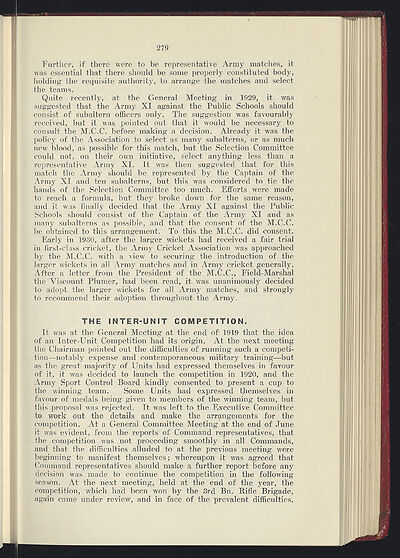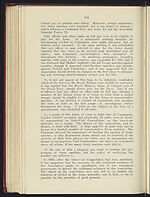1931
(293)
Download files
Complete book:
Individual page:
Thumbnail gallery: Grid view | List view

279
Further, if there were to be representative Army matches, it
was essential that there should be some properly constituted body,
holding the requisite authority, to arrange the matches and select
the teams.
Quite recently, at the General Meeting in 1929, it was
suggested that the Army XI against the Public Schools should
consist of subaltern officers only. The suggestion was favourably
received, but it was pointed out that it would be necessary to
consult the M.C.C. before making
a
decision. Already it was the
policy of the Association to select as many subalterns, or as much
new blood, as possible for this match, but the Selection Committee
could not, on their own initiative, select anything less than a
representative .Army XI. It was then suggested that for this
match the Army should be represented by the Captain of the
Army XI and ten subalterns, but this was considered to tie the
hands of the Selection Committee too much. Efforts were made
to reach a formula, but they broke down for the same reason,
and it was finally decided that the ;'army XI against the Public
Schools should consist of the Captain of the Army XI and as
inanv subalterns
as
possible, and that the consent of the M.C.C.
be obtained to this arrangement. To this the M.C.C. did consent.
Early in 1930, after the larger wickets had received a fair trial
in first-class cricket, the Army Cricket Association was approached
by the M.C.C. with a view to securing the introduction of the
larger wickets in all Army matches and in Army cricket_ generally.
After a letter from the President of the M.C.C., Field-Marshal
the Viscount Plumer, had been read, it was unanimously decided
to adopt the larger wickets for all Army matches, and strongly
to recommend their adoption throughout the Army.
THE INTER-UNIT COMPETITION.
It was at the General Meeting at the end of 1919 that the idea
of an Inter-Unit Competition had its origin. At the next meeting
the Chairman pointed out the difficulties of running such a competi-
tion—notably expense and contemporaneous military training—but
as the great majority of Units had expressed themselves in favour
of it, it was decided to launch the competition in 1920, and the
Army Sport Control Board kindly consented to present a cup to
the winning team. Some Units had expressed themselves in
favour of medals being given to members of the winning team, but
this proposal was rejected. It was left to the Executive Committee
to work out the details and make the arrangements for the
competition. At a General Committee Meeting at the end of June
it was evident, from the reports of Command representatives, that
the competition was not proceeding smoothly in all Commands,
and that the difficulties alluded to at the previous meeting were
beginning to manifest themselves; whereupon it was agreed that
Command representatives should make a further report before any
decision was made to continue the competition in the following
season. At the next meeting, held at the end of the year, the
competition, which had been won by the 3rd Bn. Rifle Brigade,
again came under review, and in face of the prevalent difficulties.
Further, if there were to be representative Army matches, it
was essential that there should be some properly constituted body,
holding the requisite authority, to arrange the matches and select
the teams.
Quite recently, at the General Meeting in 1929, it was
suggested that the Army XI against the Public Schools should
consist of subaltern officers only. The suggestion was favourably
received, but it was pointed out that it would be necessary to
consult the M.C.C. before making
a
decision. Already it was the
policy of the Association to select as many subalterns, or as much
new blood, as possible for this match, but the Selection Committee
could not, on their own initiative, select anything less than a
representative .Army XI. It was then suggested that for this
match the Army should be represented by the Captain of the
Army XI and ten subalterns, but this was considered to tie the
hands of the Selection Committee too much. Efforts were made
to reach a formula, but they broke down for the same reason,
and it was finally decided that the ;'army XI against the Public
Schools should consist of the Captain of the Army XI and as
inanv subalterns
as
possible, and that the consent of the M.C.C.
be obtained to this arrangement. To this the M.C.C. did consent.
Early in 1930, after the larger wickets had received a fair trial
in first-class cricket, the Army Cricket Association was approached
by the M.C.C. with a view to securing the introduction of the
larger wickets in all Army matches and in Army cricket_ generally.
After a letter from the President of the M.C.C., Field-Marshal
the Viscount Plumer, had been read, it was unanimously decided
to adopt the larger wickets for all Army matches, and strongly
to recommend their adoption throughout the Army.
THE INTER-UNIT COMPETITION.
It was at the General Meeting at the end of 1919 that the idea
of an Inter-Unit Competition had its origin. At the next meeting
the Chairman pointed out the difficulties of running such a competi-
tion—notably expense and contemporaneous military training—but
as the great majority of Units had expressed themselves in favour
of it, it was decided to launch the competition in 1920, and the
Army Sport Control Board kindly consented to present a cup to
the winning team. Some Units had expressed themselves in
favour of medals being given to members of the winning team, but
this proposal was rejected. It was left to the Executive Committee
to work out the details and make the arrangements for the
competition. At a General Committee Meeting at the end of June
it was evident, from the reports of Command representatives, that
the competition was not proceeding smoothly in all Commands,
and that the difficulties alluded to at the previous meeting were
beginning to manifest themselves; whereupon it was agreed that
Command representatives should make a further report before any
decision was made to continue the competition in the following
season. At the next meeting, held at the end of the year, the
competition, which had been won by the 3rd Bn. Rifle Brigade,
again came under review, and in face of the prevalent difficulties.
Set display mode to:
![]() Universal Viewer |
Universal Viewer | ![]() Mirador |
Large image | Transcription
Mirador |
Large image | Transcription
| Games and sports in the army > 1931 > (293) |
|---|
| Permanent URL | https://digital.nls.uk/248675184 |
|---|
| Description | 'Games and Sports in the Army' was an annual publication produced by the British War Office between the 1930s and 1960s. This included the Second World War. It outlines the rules and regulations for games and sports played by members of the armed forces. It features names and photographs of team members, and examples of contemporary advertising. |
|---|---|
| Shelfmark | GWB.52 |

